Analyzing the Importance of Play: Effects of Environment on Children
VerifiedAdded on 2023/06/12
|15
|1375
|103
Essay
AI Summary
This essay explores the critical role of play in childhood development, emphasizing the impact of both indoor and outdoor environments. It defines play, discusses its importance, and categorizes different types of play, including interactive, pretense, games, and performances. The essay also addresses the consequences of play deprivation, highlighting factors such as lack of parental involvement, limited access to playgrounds, and increased use of technology. It emphasizes how play awakens the senses and supports learning by enhancing social, cognitive, and emotional growth. The essay further differentiates between guided and spontaneous play, noting their respective benefits for children's creativity and problem-solving skills. It concludes by advocating for the creation of supportive play environments, both indoors and outdoors, to foster holistic child development, referencing various studies and reports to support its claims and offering insights for parents and educators.
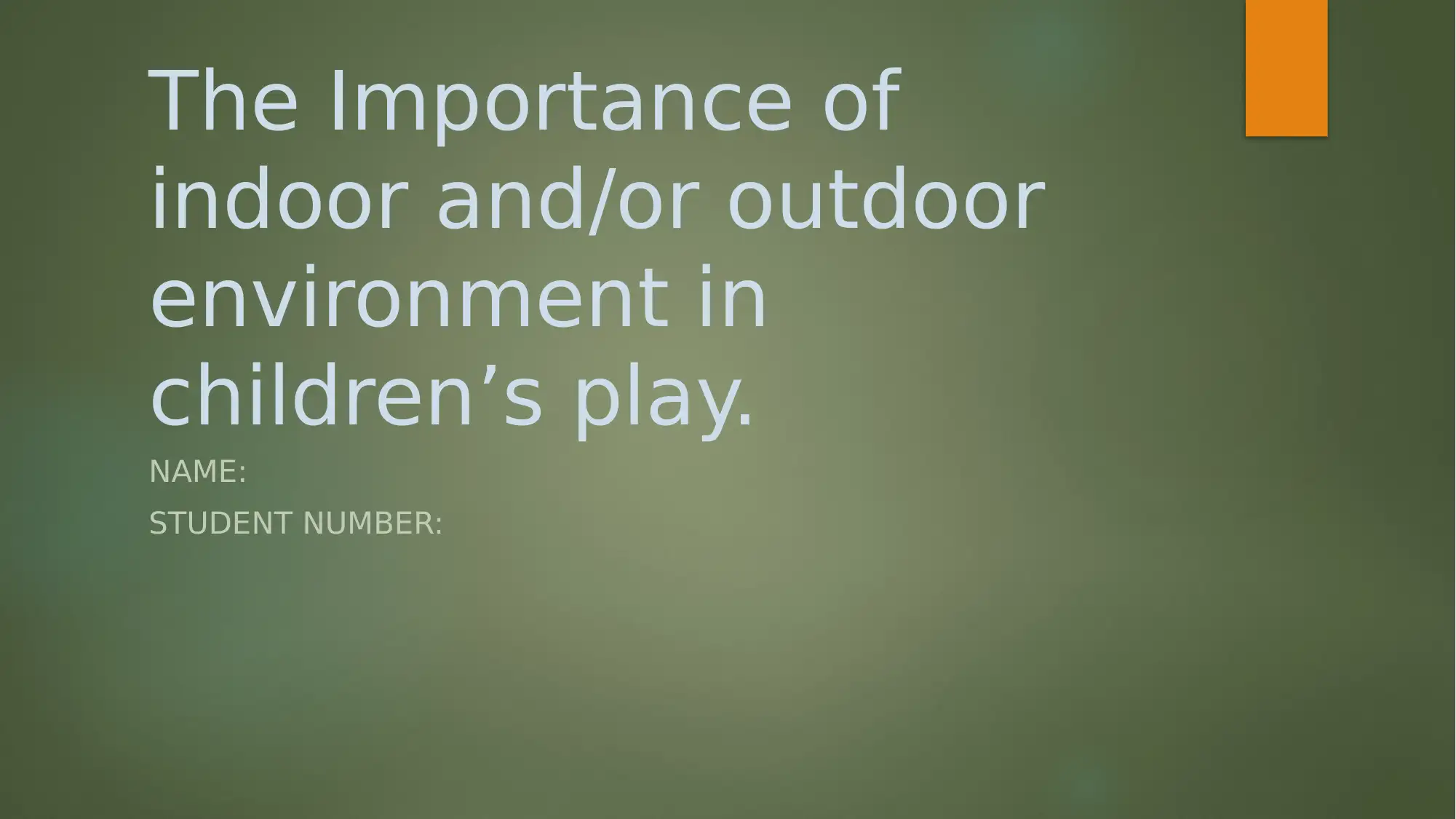
The Importance of
indoor and/or outdoor
environment in
children’s play.
NAME:
STUDENT NUMBER:
indoor and/or outdoor
environment in
children’s play.
NAME:
STUDENT NUMBER:
Paraphrase This Document
Need a fresh take? Get an instant paraphrase of this document with our AI Paraphraser
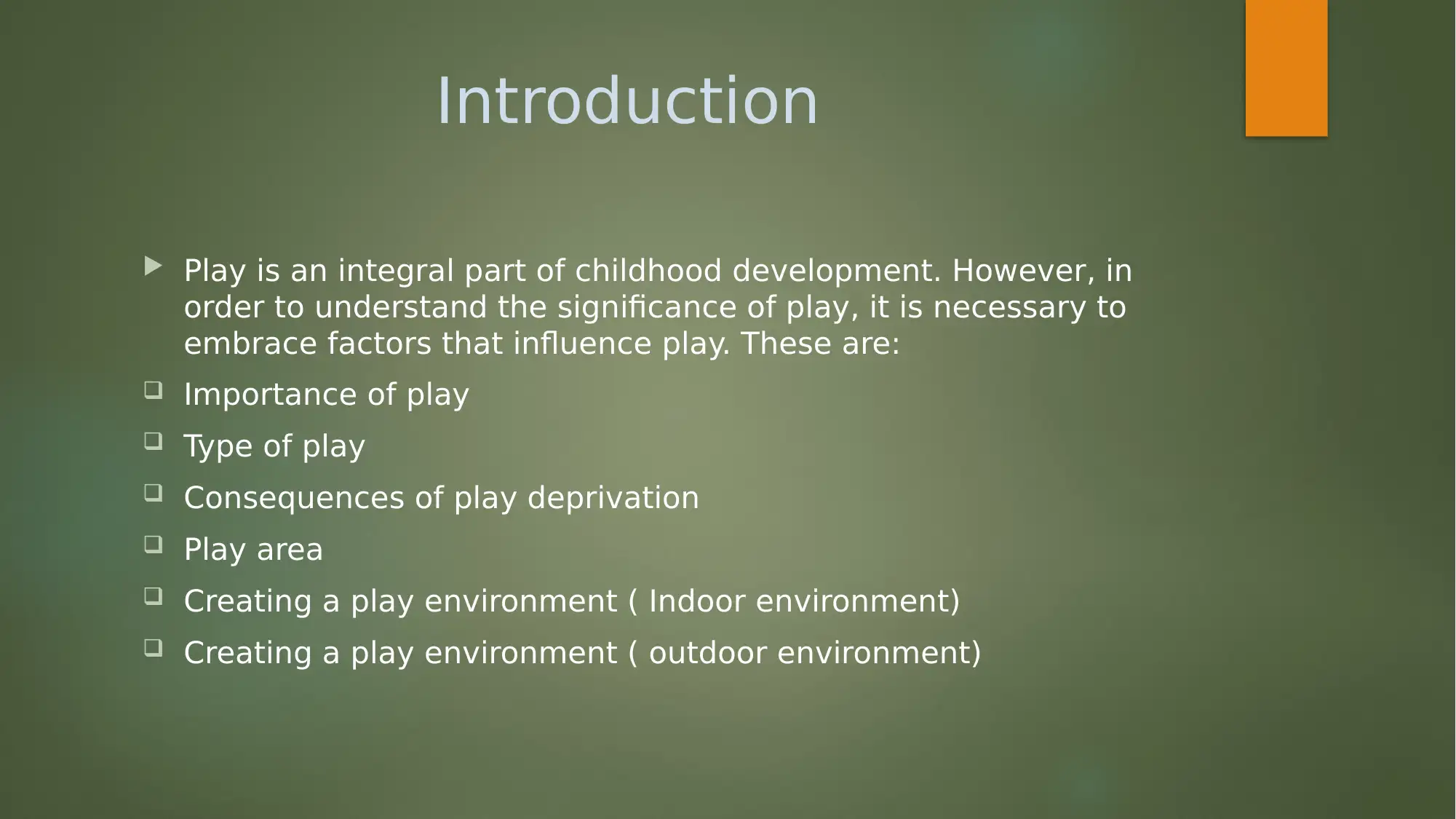
Introduction
Play is an integral part of childhood development. However, in
order to understand the significance of play, it is necessary to
embrace factors that influence play. These are:
Importance of play
Type of play
Consequences of play deprivation
Play area
Creating a play environment ( Indoor environment)
Creating a play environment ( outdoor environment)
Play is an integral part of childhood development. However, in
order to understand the significance of play, it is necessary to
embrace factors that influence play. These are:
Importance of play
Type of play
Consequences of play deprivation
Play area
Creating a play environment ( Indoor environment)
Creating a play environment ( outdoor environment)
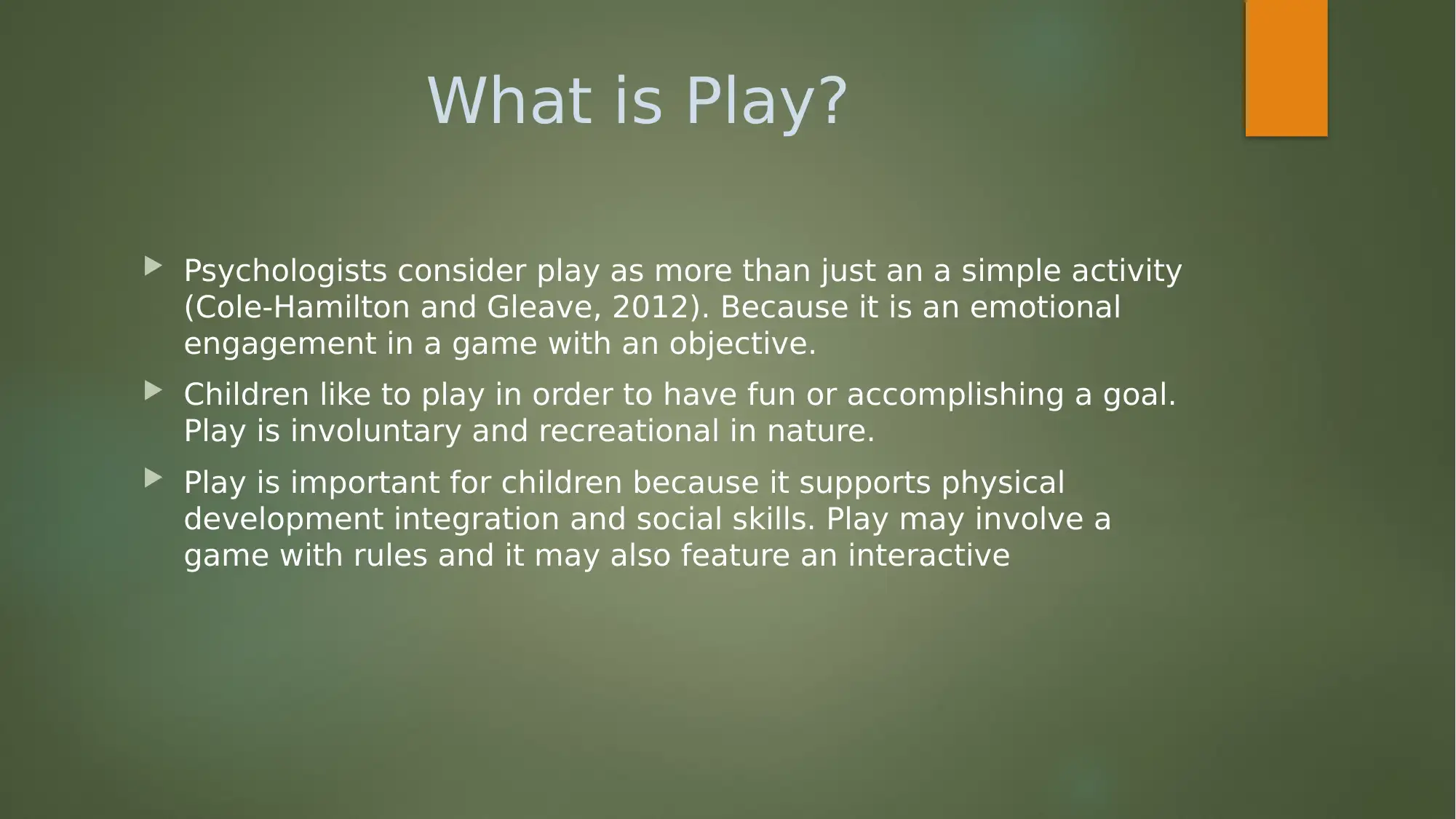
What is Play?
Psychologists consider play as more than just an a simple activity
(Cole-Hamilton and Gleave, 2012). Because it is an emotional
engagement in a game with an objective.
Children like to play in order to have fun or accomplishing a goal.
Play is involuntary and recreational in nature.
Play is important for children because it supports physical
development integration and social skills. Play may involve a
game with rules and it may also feature an interactive
Psychologists consider play as more than just an a simple activity
(Cole-Hamilton and Gleave, 2012). Because it is an emotional
engagement in a game with an objective.
Children like to play in order to have fun or accomplishing a goal.
Play is involuntary and recreational in nature.
Play is important for children because it supports physical
development integration and social skills. Play may involve a
game with rules and it may also feature an interactive
⊘ This is a preview!⊘
Do you want full access?
Subscribe today to unlock all pages.

Trusted by 1+ million students worldwide
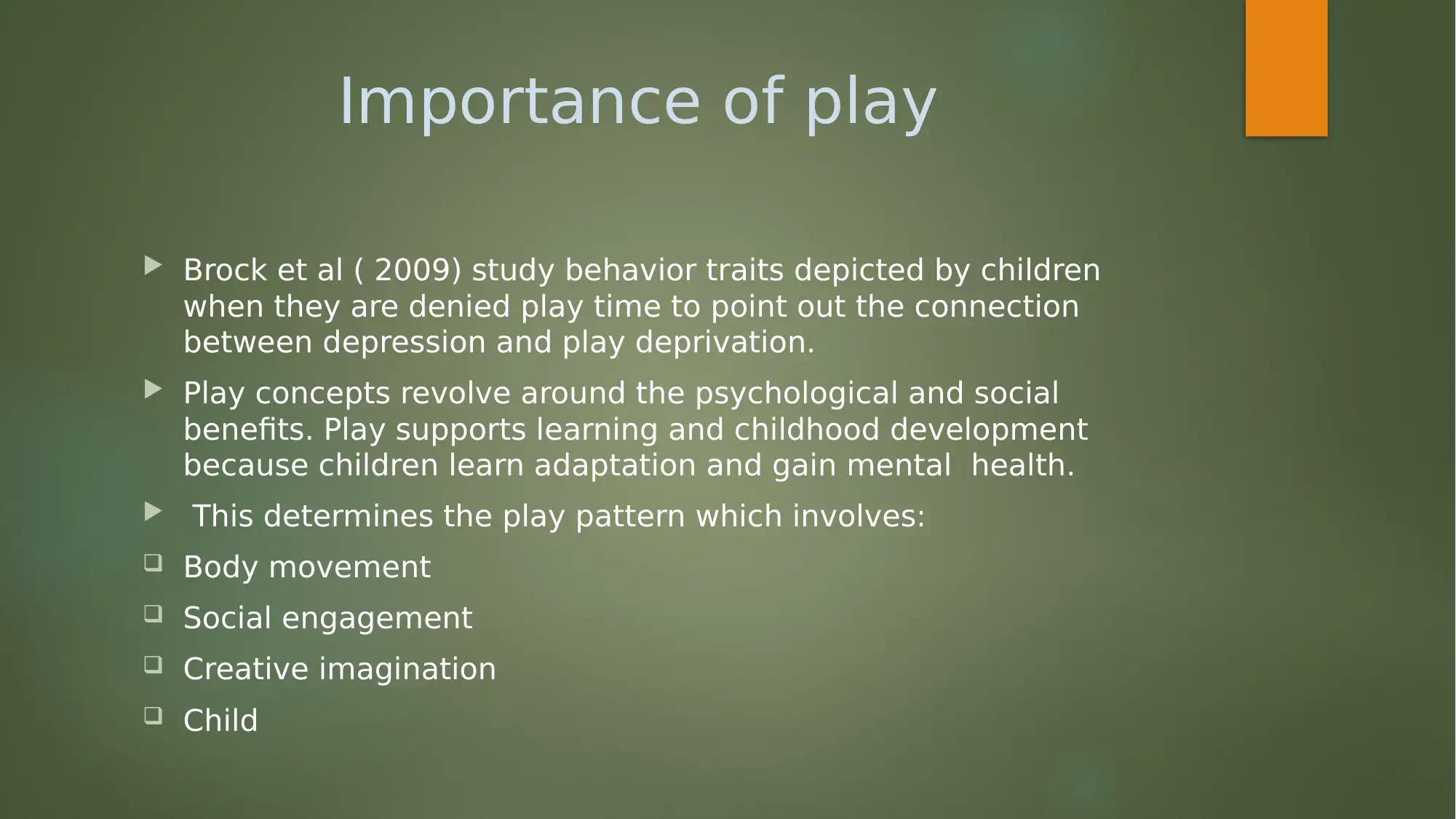
Importance of play
Brock et al ( 2009) study behavior traits depicted by children
when they are denied play time to point out the connection
between depression and play deprivation.
Play concepts revolve around the psychological and social
benefits. Play supports learning and childhood development
because children learn adaptation and gain mental health.
This determines the play pattern which involves:
Body movement
Social engagement
Creative imagination
Child
Brock et al ( 2009) study behavior traits depicted by children
when they are denied play time to point out the connection
between depression and play deprivation.
Play concepts revolve around the psychological and social
benefits. Play supports learning and childhood development
because children learn adaptation and gain mental health.
This determines the play pattern which involves:
Body movement
Social engagement
Creative imagination
Child
Paraphrase This Document
Need a fresh take? Get an instant paraphrase of this document with our AI Paraphraser
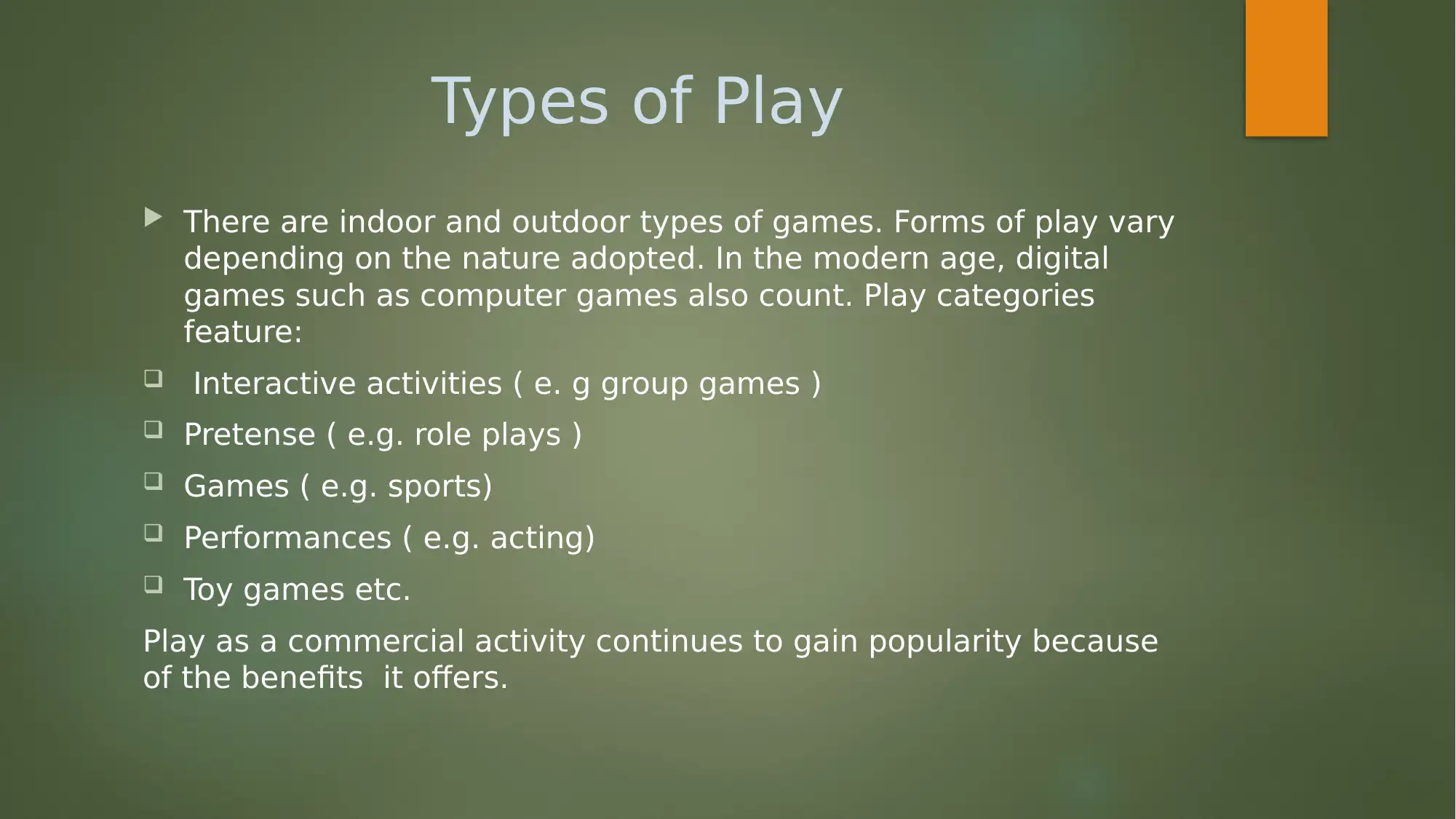
Types of Play
There are indoor and outdoor types of games. Forms of play vary
depending on the nature adopted. In the modern age, digital
games such as computer games also count. Play categories
feature:
Interactive activities ( e. g group games )
Pretense ( e.g. role plays )
Games ( e.g. sports)
Performances ( e.g. acting)
Toy games etc.
Play as a commercial activity continues to gain popularity because
of the benefits it offers.
There are indoor and outdoor types of games. Forms of play vary
depending on the nature adopted. In the modern age, digital
games such as computer games also count. Play categories
feature:
Interactive activities ( e. g group games )
Pretense ( e.g. role plays )
Games ( e.g. sports)
Performances ( e.g. acting)
Toy games etc.
Play as a commercial activity continues to gain popularity because
of the benefits it offers.
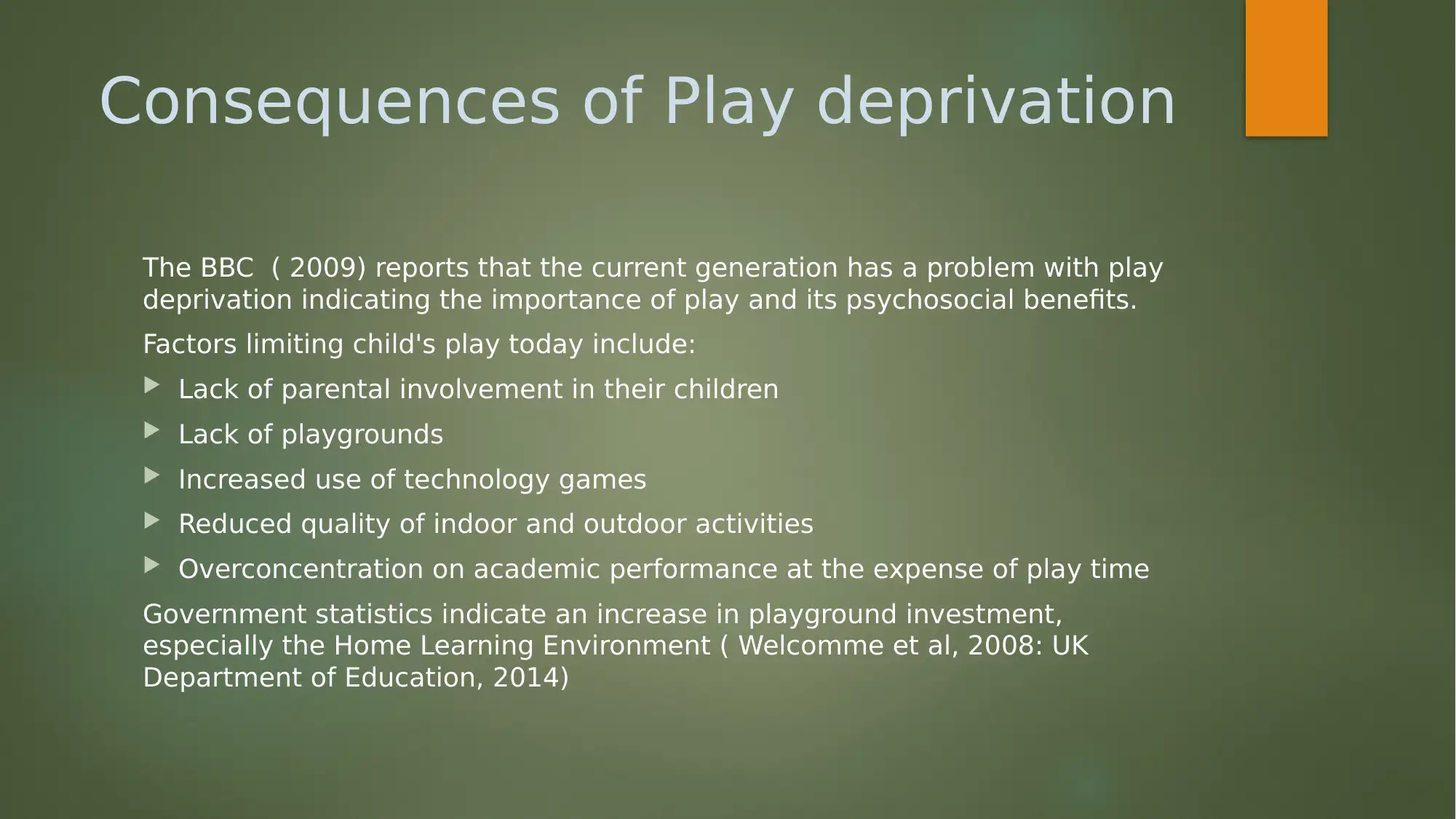
Consequences of Play deprivation
The BBC ( 2009) reports that the current generation has a problem with play
deprivation indicating the importance of play and its psychosocial benefits.
Factors limiting child's play today include:
Lack of parental involvement in their children
Lack of playgrounds
Increased use of technology games
Reduced quality of indoor and outdoor activities
Overconcentration on academic performance at the expense of play time
Government statistics indicate an increase in playground investment,
especially the Home Learning Environment ( Welcomme et al, 2008: UK
Department of Education, 2014)
The BBC ( 2009) reports that the current generation has a problem with play
deprivation indicating the importance of play and its psychosocial benefits.
Factors limiting child's play today include:
Lack of parental involvement in their children
Lack of playgrounds
Increased use of technology games
Reduced quality of indoor and outdoor activities
Overconcentration on academic performance at the expense of play time
Government statistics indicate an increase in playground investment,
especially the Home Learning Environment ( Welcomme et al, 2008: UK
Department of Education, 2014)
⊘ This is a preview!⊘
Do you want full access?
Subscribe today to unlock all pages.

Trusted by 1+ million students worldwide
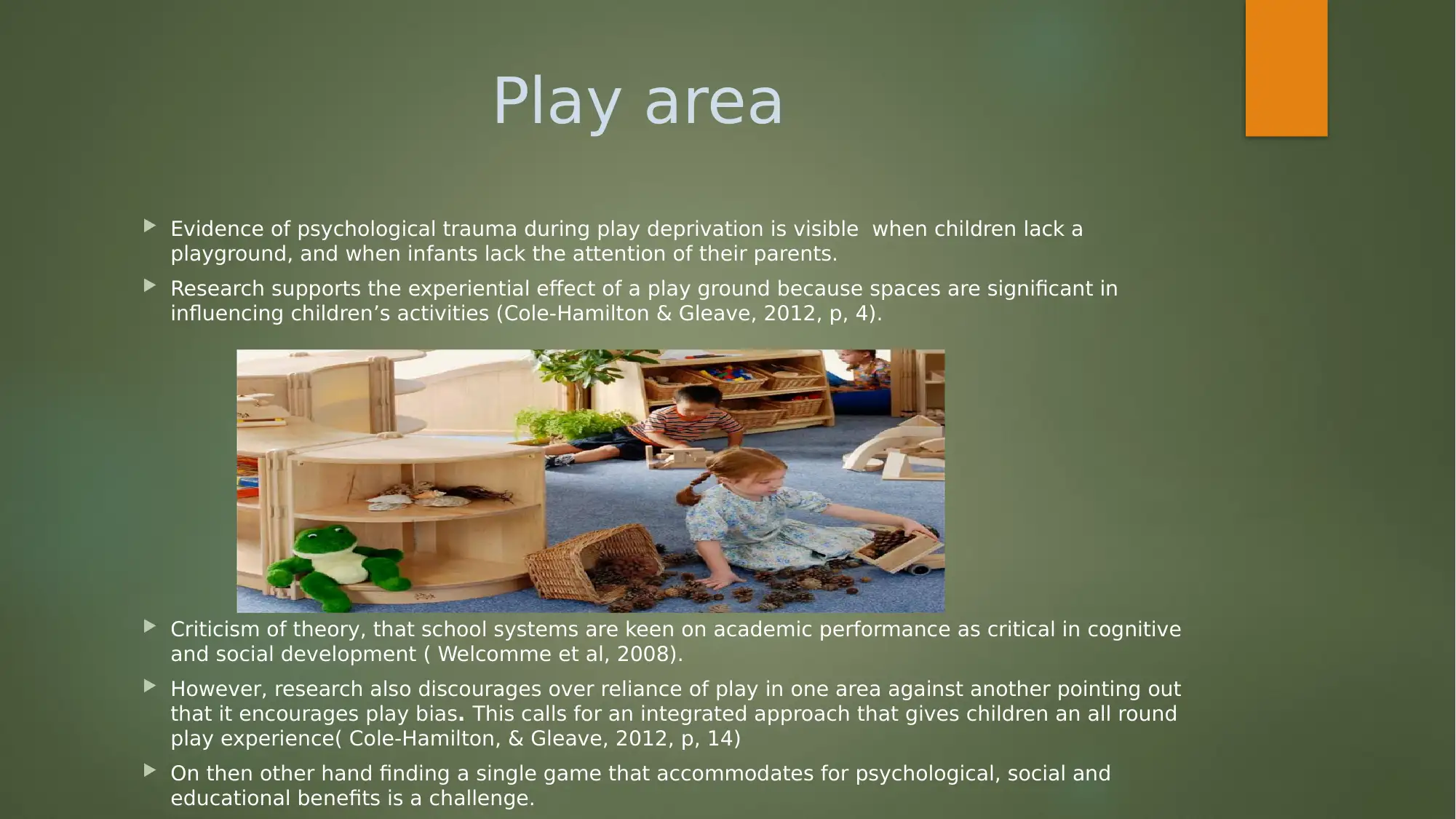
Play area
Evidence of psychological trauma during play deprivation is visible when children lack a
playground, and when infants lack the attention of their parents.
Research supports the experiential effect of a play ground because spaces are significant in
influencing children’s activities (Cole-Hamilton & Gleave, 2012, p, 4).
Criticism of theory, that school systems are keen on academic performance as critical in cognitive
and social development ( Welcomme et al, 2008).
However, research also discourages over reliance of play in one area against another pointing out
that it encourages play bias. This calls for an integrated approach that gives children an all round
play experience( Cole-Hamilton, & Gleave, 2012, p, 14)
On then other hand finding a single game that accommodates for psychological, social and
educational benefits is a challenge.
Evidence of psychological trauma during play deprivation is visible when children lack a
playground, and when infants lack the attention of their parents.
Research supports the experiential effect of a play ground because spaces are significant in
influencing children’s activities (Cole-Hamilton & Gleave, 2012, p, 4).
Criticism of theory, that school systems are keen on academic performance as critical in cognitive
and social development ( Welcomme et al, 2008).
However, research also discourages over reliance of play in one area against another pointing out
that it encourages play bias. This calls for an integrated approach that gives children an all round
play experience( Cole-Hamilton, & Gleave, 2012, p, 14)
On then other hand finding a single game that accommodates for psychological, social and
educational benefits is a challenge.
Paraphrase This Document
Need a fresh take? Get an instant paraphrase of this document with our AI Paraphraser
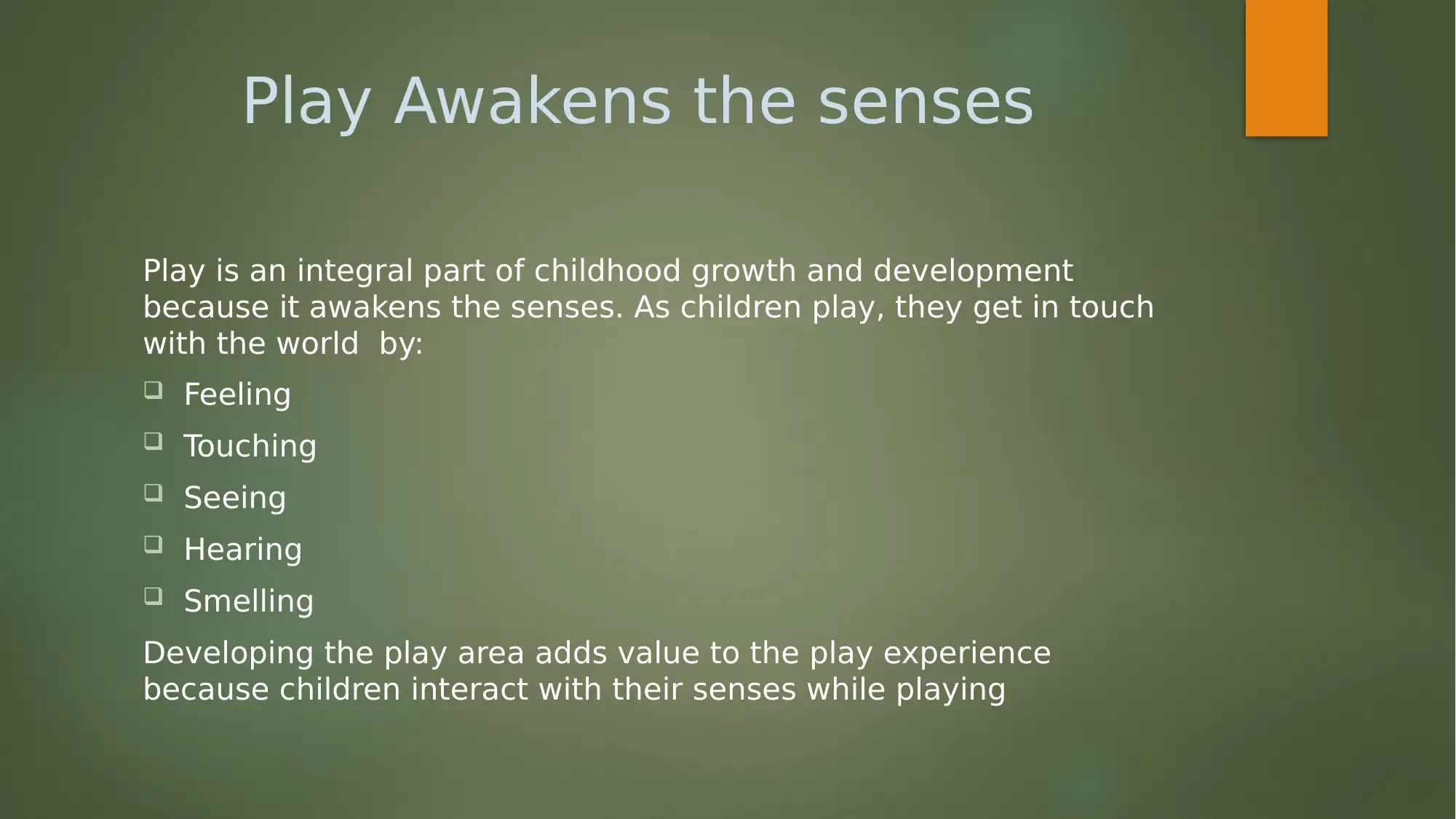
Play Awakens the senses
Play is an integral part of childhood growth and development
because it awakens the senses. As children play, they get in touch
with the world by:
Feeling
Touching
Seeing
Hearing
Smelling
Developing the play area adds value to the play experience
because children interact with their senses while playing
Play is an integral part of childhood growth and development
because it awakens the senses. As children play, they get in touch
with the world by:
Feeling
Touching
Seeing
Hearing
Smelling
Developing the play area adds value to the play experience
because children interact with their senses while playing
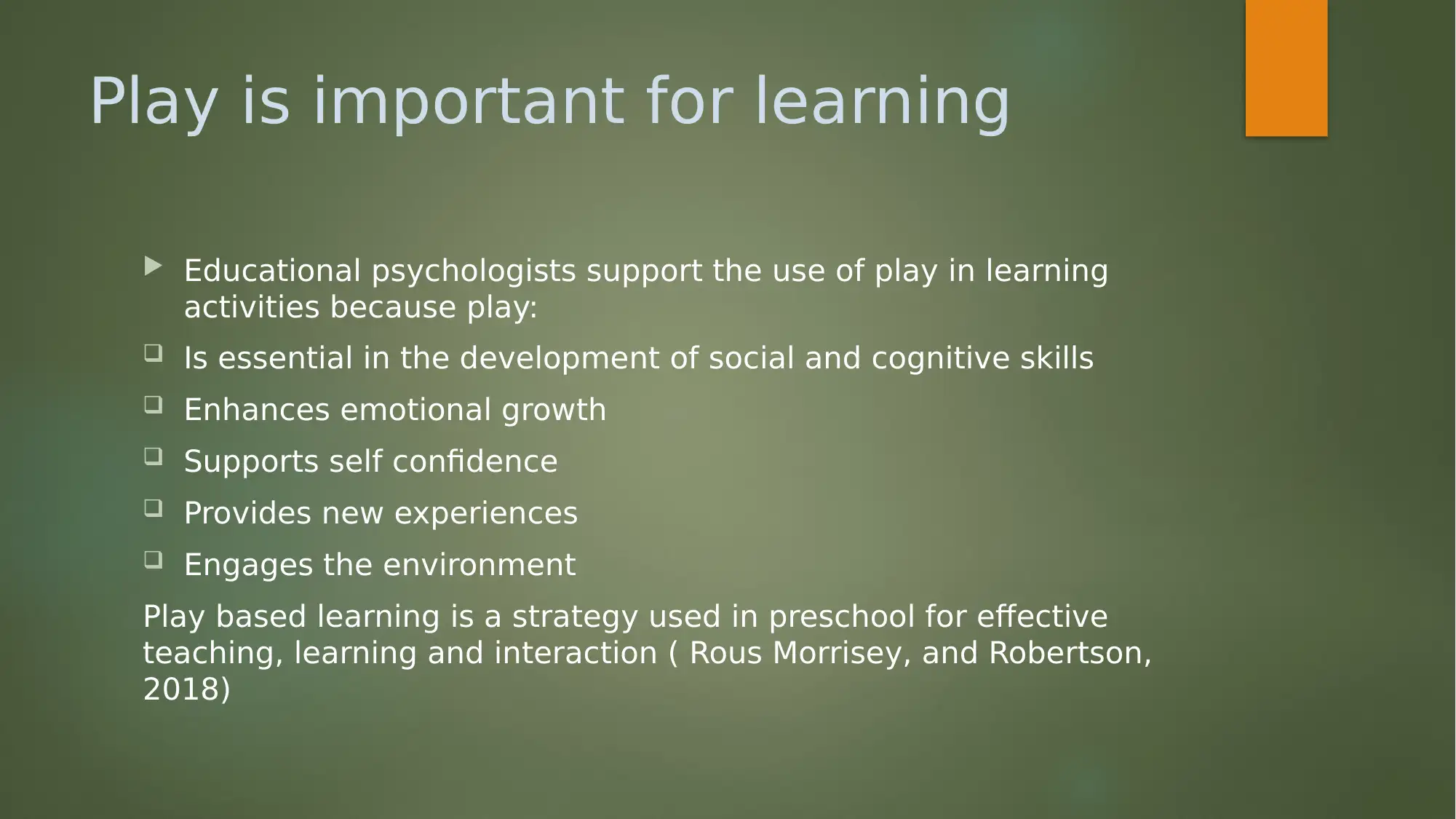
Play is important for learning
Educational psychologists support the use of play in learning
activities because play:
Is essential in the development of social and cognitive skills
Enhances emotional growth
Supports self confidence
Provides new experiences
Engages the environment
Play based learning is a strategy used in preschool for effective
teaching, learning and interaction ( Rous Morrisey, and Robertson,
2018)
Educational psychologists support the use of play in learning
activities because play:
Is essential in the development of social and cognitive skills
Enhances emotional growth
Supports self confidence
Provides new experiences
Engages the environment
Play based learning is a strategy used in preschool for effective
teaching, learning and interaction ( Rous Morrisey, and Robertson,
2018)
⊘ This is a preview!⊘
Do you want full access?
Subscribe today to unlock all pages.

Trusted by 1+ million students worldwide
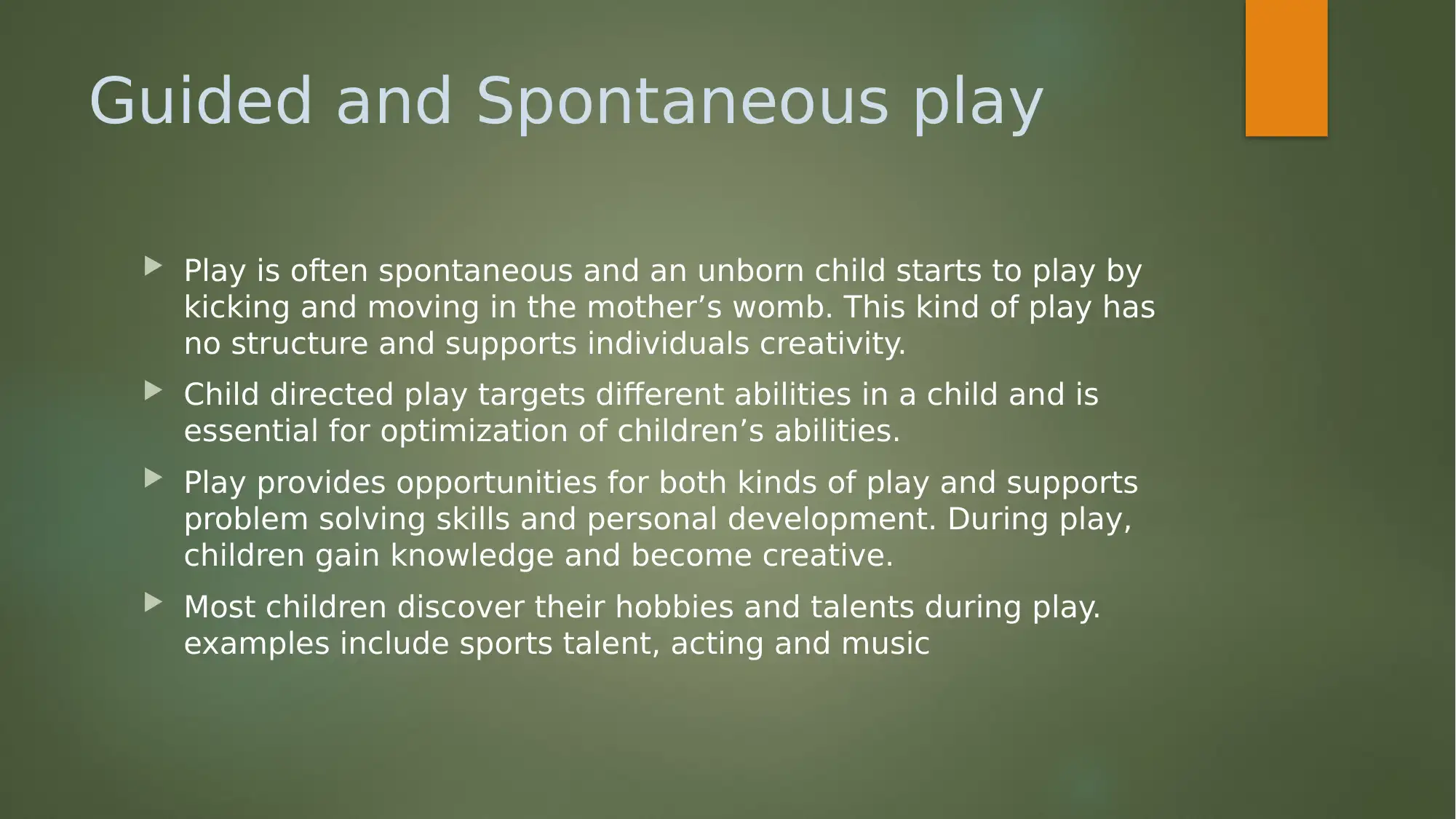
Guided and Spontaneous play
Play is often spontaneous and an unborn child starts to play by
kicking and moving in the mother’s womb. This kind of play has
no structure and supports individuals creativity.
Child directed play targets different abilities in a child and is
essential for optimization of children’s abilities.
Play provides opportunities for both kinds of play and supports
problem solving skills and personal development. During play,
children gain knowledge and become creative.
Most children discover their hobbies and talents during play.
examples include sports talent, acting and music
Play is often spontaneous and an unborn child starts to play by
kicking and moving in the mother’s womb. This kind of play has
no structure and supports individuals creativity.
Child directed play targets different abilities in a child and is
essential for optimization of children’s abilities.
Play provides opportunities for both kinds of play and supports
problem solving skills and personal development. During play,
children gain knowledge and become creative.
Most children discover their hobbies and talents during play.
examples include sports talent, acting and music
Paraphrase This Document
Need a fresh take? Get an instant paraphrase of this document with our AI Paraphraser
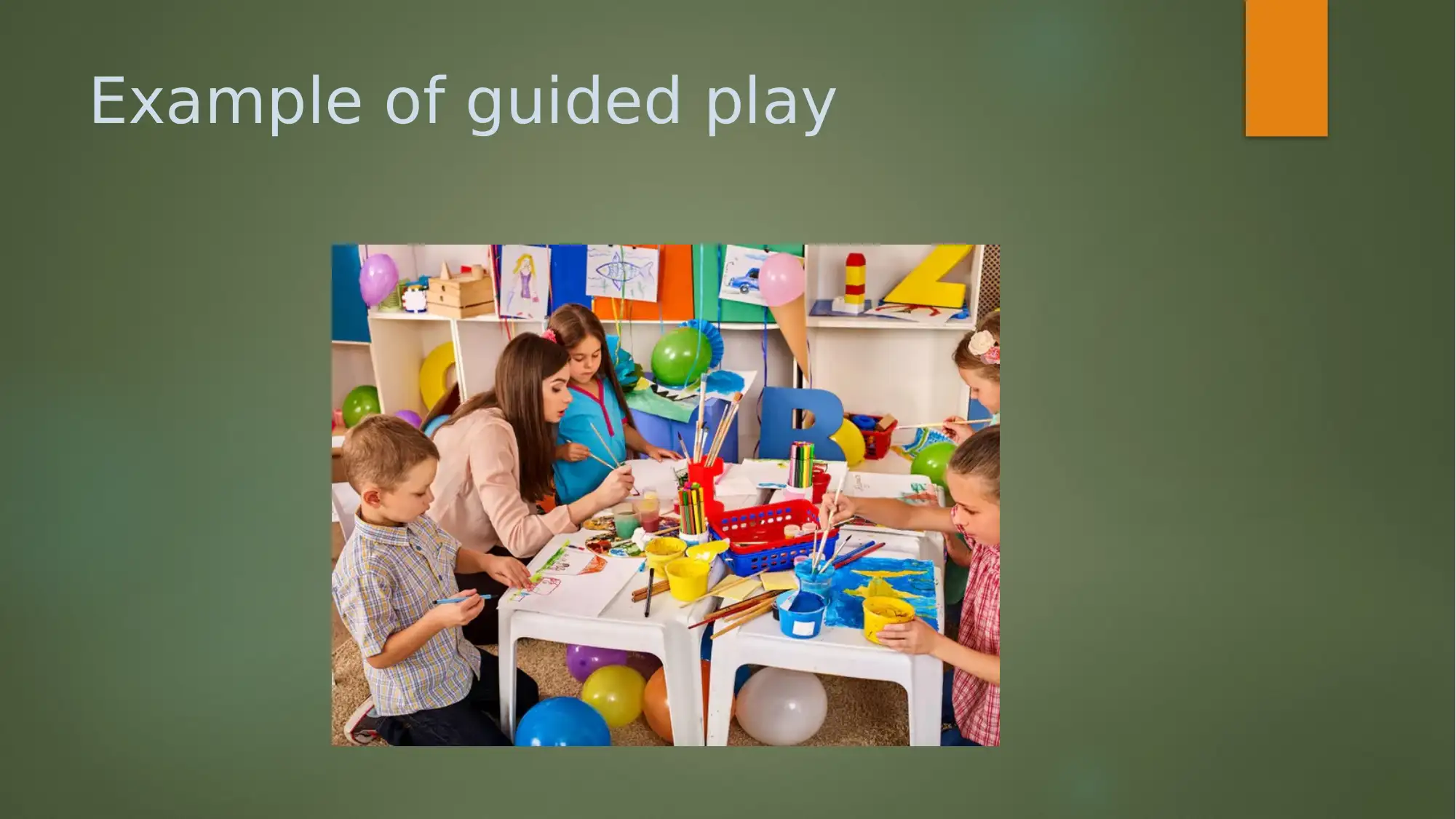
Example of guided play
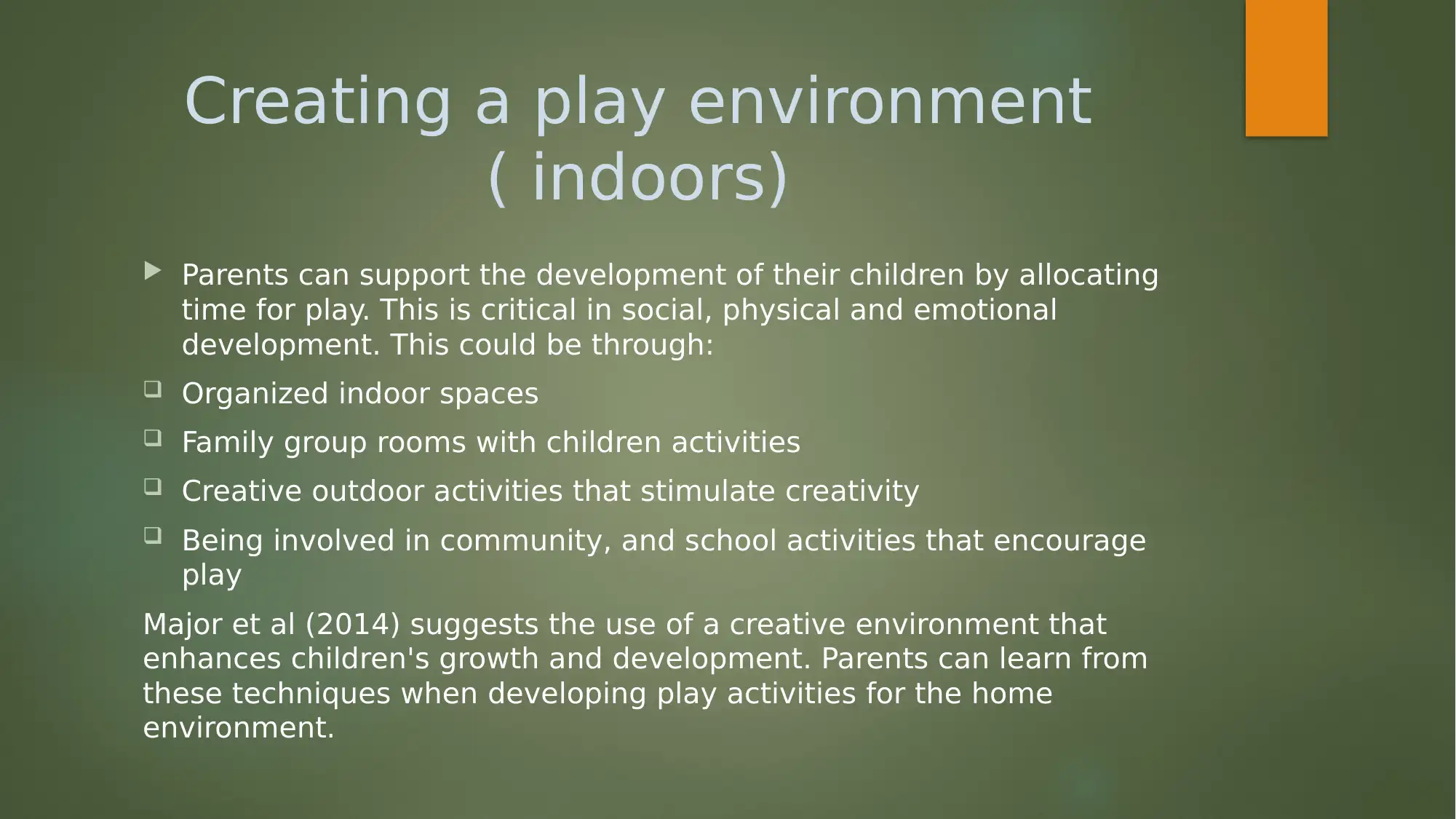
Creating a play environment
( indoors)
Parents can support the development of their children by allocating
time for play. This is critical in social, physical and emotional
development. This could be through:
Organized indoor spaces
Family group rooms with children activities
Creative outdoor activities that stimulate creativity
Being involved in community, and school activities that encourage
play
Major et al (2014) suggests the use of a creative environment that
enhances children's growth and development. Parents can learn from
these techniques when developing play activities for the home
environment.
( indoors)
Parents can support the development of their children by allocating
time for play. This is critical in social, physical and emotional
development. This could be through:
Organized indoor spaces
Family group rooms with children activities
Creative outdoor activities that stimulate creativity
Being involved in community, and school activities that encourage
play
Major et al (2014) suggests the use of a creative environment that
enhances children's growth and development. Parents can learn from
these techniques when developing play activities for the home
environment.
⊘ This is a preview!⊘
Do you want full access?
Subscribe today to unlock all pages.

Trusted by 1+ million students worldwide
1 out of 15
Related Documents
Your All-in-One AI-Powered Toolkit for Academic Success.
+13062052269
info@desklib.com
Available 24*7 on WhatsApp / Email
![[object Object]](/_next/static/media/star-bottom.7253800d.svg)
Unlock your academic potential
Copyright © 2020–2025 A2Z Services. All Rights Reserved. Developed and managed by ZUCOL.





